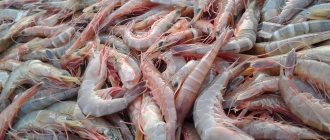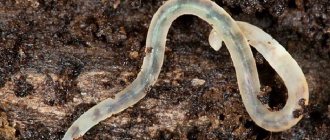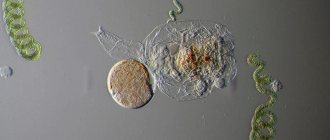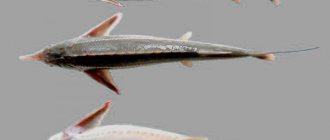Almost every aquarist begins his acquaintance with the world of aquatic animals and plants with aquarium fish. I won’t be mistaken if I say that the vast majority of aquarium lovers started their hobby with an aquarium of ten to fifteen liters, and only then purchased a larger aquarium, 50-70 liters. Some did not stop there and acquired a 150-300 liter aquarium, in which they housed and bred the coveted cichlids.
Something is missing, isn't it? And there are not enough other aquatic inhabitants. And now I'm not talking about snails, frogs or turtles. We're talking about shrimp. It's time you got them. Read on to learn about all the nuances of keeping and caring for shrimp in an aquarium.
Shrimp in an aquarium. What kind of aquatic animal is this?
Shrimp are crustaceans from the order Decapods. Various types of shrimp live in both salty sea waters and fresh water. Although shrimp look like crayfish, they do not have claws. From crayfish, shrimp have only a tail and antennae.
Shrimp have a good sense of smell and touch. An interesting distinctive feature of shrimp is that they can turn their eyes in different directions, which distinguishes them from fish. The body of shrimp is segmented into antennae, jaws, jaws and shell (caudal, abdominal and thoracic sections of the body).
The shrimp's oral apparatus consists of 3 pairs of jaws that grind food, and jaws that hold it at the mouth. The remaining 5 pairs of thoracic limbs are designed for grasping prey and crawling. Females have pleopods (abdominal legs) to carry eggs. In males, their first pair has degenerated into a copulatory organ.
The lifespan of shrimp is from one to two years. The color is very varied: cherry, blue, yellow or green.
Aquarium shrimp usually originate from Asia (usually the mountain rivers of Japan). The size of shrimp in the aquarium does not exceed 6-8 centimeters in length. The shrimp is a peace-loving creature that will not harm its neighbors in the aquarium. On the contrary, fish are not averse to snacking on shrimp. Most often, two types of shrimp are kept and bred in an aquarium: neocardina cherry and neocardina special.
What types are suitable for home cultivation?
There are many different types of shrimp, but not all of them are suitable for growing at home. Decorative shrimp suitable specifically for aquariums include several of the most popular species, distinguished by their spectacular appearance, unusual coloring, combined with fairly simple maintenance and unpretentiousness in terms of care and reproduction.
Tiger
It has a specific striped color, which is why it got its name. The adult size is about 3 cm. It feeds on traditional fish food and algae.
Amano
A very beautiful and large decorative shrimp, the length of which can reach 6-7 cm. It differs from other representatives of this species in its almost absolute transparency. The Amano shrimp feeds mainly on organic matter and algae.
It should be noted that for successful breeding and reproduction of Amano females, it is necessary to separate them from other aquarium inhabitants and place them in a separate, sterilely clean tank, providing round-the-clock additional lighting until the offspring are fully strengthened and are ready to move into a general aquarium.
Cherry
The cherry shrimp is one of the most popular and beloved species by aquarists. This demand is explained by the surprisingly bright, rich cherry color of the crustacean’s body. Moreover, under different conditions of detention, its color can change shades to orange, brick brown, terracotta, bright scarlet.
At the same time, cherry shrimp are absolutely not picky about food, do not require any special conditions of detention, have excellent adaptability, grow and reproduce quickly, and without any third-party intervention.
Bloody Mary
This shrimp with such a spectacular name was artificially bred through selective breeding. This species is characterized by an intense bright red color, truly bloody. Bloody Mary is completely unpretentious and performs not only a decorative, but also another useful function in the aquarium, cleaning the artificial reservoir from food residues, various microorganisms, sediments, and contaminants.
It has a particularly peaceful and friendly character, thanks to which it gets along well with both other varieties of shrimp and other aquarium inhabitants. The only thing that Bloody Mary needs for full development and active reproduction is purified water, a bottom covered with moss, and various green spaces. Moreover, the more plants there are in the aquarium, the better for it.
Shrimp molting in an aquarium
Shrimp in an aquarium molt regularly. A day or two before the shrimp sheds its chitinous shell, and two to three days after, the shrimp do not feed on anything. When the shell is shed, the shrimp grows. Since the skins of shrimp become soft during the molting period, the shrimp are especially defenseless, which forces them to hide in various types of shelters: under stones, in grottoes, in dense thickets of aquatic plants.
An interesting feature is the fact that during the molting period, shrimp are able to restore lost limbs, and the speed of restoration directly depends on the age of the shrimp: the younger it is, the faster the restoration of hard tissues and limbs occurs.
Direct
Nutrition
In a common aquarium, they eat uneaten leftover food from aquarium fish, various organic matter, algae, and those same plant additives (see paragraph above). And only as a last resort, when food sources are running out, they will switch to ornamental plants. It is worth noting that depending on the species, the diet may be different; there are both vegetarians and carnivores. They can do without food for a long time, feeding on organic microparticles that are constantly present in a mature aquarium. This property is relevant when kept in a separate tank, where there are no other inhabitants. You can safely go on vacation for a couple of weeks without fear for your pets.
Aquarium for keeping shrimp
A shrimp aquarium is popularly called a shrimp tank. Shrimp in an aquarium can be kept even in 10 liters, which is enough for the life of 10-15 shrimp. Stick to the rule of one liter per shrimp. Just remember that shrimp multiply very quickly, so you should think in advance about a larger volume. A larger volume means an aquarium from 40 to 80 liters.
The temperature range for keeping shrimp varies from 15 to 30 degrees Celsius, which in itself is amazing. The ideal temperature for shrimp is the same temperature as most tropical fish - 25 degrees Celsius. A decrease in temperature to 18 degrees Celsius affects the activity of shrimp, they become inactive. Sudden changes in temperature, just like in fish, cause stress and decreased immunity, which can subsequently lead to the death of the shrimp. Increasing the temperature to 30 degrees Celsius or higher can also be detrimental to shrimp or lead to their complete sterilization.
When keeping shrimp, the soil is preferable to the dark fraction; black color is perfect. Although, in general, the color of the soil is not important.
With filtering, things are ambiguous. Shrimp do not need filtration. However, filtration is necessary for most aquarium plants. Therefore, you should take care that newborn shrimp are not sucked into the filter and scattered throughout the aquarium.
From the vegetation in the aquarium for shrimps, Java moss and cladophora are best suited. Since shrimp become discolored in strong lighting, it is worth limiting yourself to a light intensity that will allow the shrimp to see the food and will not allow the plants to die from lack of light.
Replacement in an aquarium with shrimp is done according to the standard rule of aquarium management - once a week by a third.
ATTENTION! An aquarium with shrimp must be covered with a lid. Otherwise, the shrimp may escape into the air from the water, which will inevitably lead to its death.
Where to begin
Having decided on the type of shrimp that you want to place in your aquarium, you need to purchase an initial batch for the purpose of further breeding it. It is very important to choose a good, reliable supplier who offers truly high-quality products. Here it is worth paying attention to the reviews of other customers and the duration of operation of the outlet itself.
Another important nuance is the location of the outlet itself. It is advisable that it be located close to home. Because during long-term transportation you will have to pay a fairly large amount of money for special containers that maintain the viability of the shrimp.
Beginners who are not very familiar with the quality of shrimp are recommended to seek advice from professional experts and qualified specialists. It is very important not to make a mistake and to collect as much information as possible about the chosen species and its characteristics in order to purchase an ornamental shrimp, and not a predatory one, which after a short time will grow to 20-30 cm and will pose a real danger to other aquarium inhabitants.
When choosing, you need to especially carefully examine the shell - it should be dense and clean, without any specific plaque or dark or white spots. Transparent shrimp should be just that, and a cloudy, milky-white color indicates a disease of the individual.
Many experienced people who have been farming shrimp for a long time advise another option - a simpler and more economical one. Its essence lies in the acquisition not of adults, but of baby shrimp. However, this method is only suitable for people who have information about the peculiarities of growing and breeding crustaceans, to which shrimp belongs, in an artificial environment, since in order for the larva to turn into an adult healthy individual, certain conditions, care and proper nutrition will be required.
But on the other hand, given the fact that the average lifespan of a shrimp in an artificial environment is no more than 2 years, and determining their age category is an extremely difficult task even for an experienced aquarist, there are risks of acquiring an already elderly individual, which will soon die from old age.
It is also not recommended to purchase pregnant females with caviar, since they are extremely difficult to tolerate transportation and have difficulty adapting to living in a new environment, which can lead to the death of not only the offspring, but also the expectant mother herself.
After the choice has been made, the shrimp should be placed in a special bag with a small amount of water and aquatic greens.
For faster and more comfortable acclimatization of shrimp, it is better not to immediately place them in the aquarium, but to place them in a tank of water directly in the bag in order to compare temperature conditions. After which the new inhabitants can be released into free swimming.
If shrimp or fish already live in the aquarium, then it is necessary to temporarily turn off artificial lighting. In general, experts recommend introducing new shrimp in the evening hours after daylight hours have ended in order to avoid attacks by old-timers on newcomers and to facilitate the process of adaptation of ornamental shrimp to a new environment.
Water parameters for keeping shrimp in an aquarium
For shrimp, aeration of the water in the aquarium is EXTREMELY important, since shrimp are extremely sensitive to the presence of oxygen in the water. In addition, the water in the aquarium should be clean and well-settled, without a hint of chlorine content in the water. Shrimp are categorically intolerant of chlorine and may die. For the same reason, the use of any kind of aerosols and sprays is prohibited in a room with an aquarium in which shrimp are located.
Shrimp in an aquarium need water hardness from 4 to 10, and the pH should be at the level of 6-7. Copper in water causes instant death of shrimp. But the calcium content in the water is welcome, since calcium favors the development of a durable shell in the shrimp.
How much money do you need to start a business?
The amount of investment in this business depends on the type of shrimp you will breed and the scale of production. To grow aquarium representatives, 20-40 thousand rubles are enough, but for mass breeding of shrimp, which are eaten as food, more investments will be needed. Below is an approximate list of costs for starting a business:
| Expense item (per year) | Cost in rubles |
| Purchase of young animals (1000 pcs) | 40 thousand |
| Equipment | 760 thousand |
| Renting premises | 190 thousand |
| Purchase of feed | 155 thousand |
| Salary (2 employees) | 350 thousand |
| Communal payments | 160 thousand |
| Other expenses | 55 thousand |
| General expenses | 1,710 thousand |
You may be interested in: Dry cleaning as a business
In total, starting a business on an industrial scale will cost approximately 1.7 million rubles. In this case, you can expect to receive 5 tons of products.
Feeding shrimp in an aquarium
Shrimp are almost omnivorous. Shrimp even eat dirt from the aquarium filter sponge. Therefore, they are classified as aquarium orderlies. Algae eaters and snails are not competitors for shrimp in the role of orderlies. Shrimp take food only from the bottom of the aquarium.
You should feed shrimp in an aquarium no more than once every two days. Shrimp easily tolerate long breaks in feeding, which may occur if you go on vacation or a business trip.
Food for shrimp includes the remains of plants, the corpses of aquarium inhabitants (for example, you can deliberately crush snails and feed their corpses to shrimp), ordinary flake and frozen or dry food (bloodworms, cycles, daphnia) for aquarium fish. Shrimp even eat their own shed shells! Sometimes shrimp can be fed with boiled vegetables or catfish tablets.
Feeding crustaceans
Shrimp are omnivorous. They are constantly in search of food. They feed on dead parts of plants, gnaw algae and fish corpses. They should be fed every other day, and it is better not to do this on the day when the water is changed. They tolerate stress better when they are hungry.
Suitable food for aquarium shrimp:
- dry daphnia;
- any live food;
- tablets with spirulina;
- bloodworm;
- cod meat;
- dry vegetable flakes;
- Artemia;
- tubifex
A feature of their diet is the need for a balanced diet containing calcium. When they grow, they constantly molt and, due to a lack of calcium, begin to eat their shell, which they just got rid of.
A special feature of shrimp nutrition is the need for a balanced feed containing calcium.
Shrimp breeding
Shrimp in an aquarium easily reproduce on their own. Shrimp are very fertile, so don't buy too many of them at the pet store. Shrimp are dioecious. Male shrimp are usually smaller than females and appear visually paler.
For reproduction, it is enough to provide clean water without chlorine and adequate nutrition. The incubation period for eggs is 3-4 weeks, after which the fry are born. Throughout the incubation period, the female carries the eggs, first on her back, and after molting - under her abdomen.
The mating process, which lasts only a couple of seconds, is preceded by the release of special pheromones into the water by the female, which are captured by the males. Pheromones are released by the shrimp immediately after shedding its shell. The fry are born fully viable and are able to feed on their own. The number of fry is usually about 30 pieces.
How to breed macrobrachium shrimp
They begin to breed livestock by catching breeders in rivers using nets and traps. Earthworms and small shrimp are used as bait for this (Figure 10).
Males should be kept separately from females and one per aquarium. If this is not possible, then when molting individuals appear, the males are removed for several hours. Recently moulted females are placed with the male in an aquarium, where mating occurs. If females caught from a reservoir contain eggs, they are kept in separate spawning aquariums.
When eggs develop in spawning grounds, the water must be aerated. When the color of the eggs changes, add sea salt to the aquarium. For their cultivation, cages with a slight slope are used.
Figure 10. Aquarium breeding of the Macrobrachium breed
Water for breeding should be neutral, with a salinity of 12% and a temperature of 26-28 degrees. The water should be constantly aerated and changed every week. There should be no chlorine in the water. Small individuals begin to be fed at the age of 2-3 days, using planktonic crustaceans.
When the bulk of the metamorphosis stage is reached, the larvae are transferred to ponds. Before this, the larvae must get used to fresh water. In ponds, the bottom is left muddy and the walls are made of cement. They are constantly supplied with aerated and running water. At the bottom, be sure to make a shelter from branches, gravel, and roots so that the animals can hide after molting.
Compatibility of aquarium shrimp with fish
As mentioned earlier, aquarium fish, for example, even such as bettas, swordtails, and molynesias, are not averse to snacking on shrimp. Therefore, it is necessary to select fish in such a way that the fish’s oral cavity does not allow the shrimp to be swallowed. Microrasboras, neons, Endler's guppies, micropecilia, and paratocinclus will be excellent neighbors for shrimp.
But still, make it a rule not to keep any fish in the shrimp tank. It will not be superfluous to organize additional shelters for shrimp in the form of grottoes. Many aquarists believe that shelters can protect shrimp even from aggressive species of aquarium fish.
How much can you earn from shrimp farming?
When producing about 5 tons of shrimp per year with a price of 350-450 rubles per 1 kg, the income during this time will be about 1.4-2.5 million rubles. If a year passes without losses, then the business will pay off. Otherwise, the investment will pay off in 2-3 years.
In general, this is a fairly profitable business if you take into account all the nuances. It is worth considering that such production requires a lot of electricity to heat the reservoir, so it is worth taking a closer look at alternative sources of electricity. This way you can significantly reduce costs.
Types of aquarium shrimp
Cherry shrimp
The name speaks for itself. The color of the shrimp is shades of red - cherry, tangerine or garnet. The cherry shrimp is the most popular among aquarists due to its unpretentiousness, fertility and availability. This type of shrimp measures no more than 2-3 centimeters. Life expectancy is 1.5-2 years.
Tiger shrimp
Tiger shrimp are never crossed with cherry shrimp. Tiger prawns usually live for about two years. The size of the shrimp is usually 2-3 centimeters.
Amano
Amano shrimp are classified as large species, their body length reaches 6 centimeters. A distinctive feature of amano is the transparency of the shrimp’s body. It is very difficult to breed this type of aquarium shrimp in an aquarium, since their larvae can only develop in sea water.
More materials about aquariums
Did you like the article? Not good? Then it is possible that you will write yours much better. Just follow the link Posting articles and read the rules for publishing articles on the MultiBlog67.RU website.
Description and features
Shrimp belong to the suborder of invertebrates, the family of crustaceans. There are a huge number of their varieties. In the natural environment, as a rule, large individuals are found, the size of which can reach 15 cm. In addition, breeders have bred a number of ornamental breeds with miniature sizes (from 2 to 5 cm) and interesting, bright colors.
Blue, cherry, yellow and green shrimp are very popular among aquarists. Lovers of the exotic are delighted by the transparent shrimp - an amazing creature that really practically glows from the inside, with such thin skin that, if desired, you can examine its internal organs in detail.
Malaysian giants
Crustaceans are best suited for farming in Russia. They are very large, can reach a length of up to 33 cm, grow quickly and reproduce rapidly. In addition, they are unpretentious in care and nutrition.
Development to an adult organism occurs in several stages. The most difficult period is the molting period. Throughout its existence, the shrimp molts 13 times, each time becoming larger. Adult organisms undergo molting once every 8 weeks. During this period, most of the individuals may die. Therefore, at this difficult moment you need to carefully monitor the living conditions of the shrimp.
These shrimp eat food crops
Favorable water temperature for reproduction is +20°…+27°С. Stones, pieces of wood and pipes are used at the bottom of an aquarium, pool or pond. They are needed for shelter. The number of shrimp in one container should not be excessive, otherwise the individuals will begin to devour each other, which brings huge losses to the business.
Malaysian shrimp are offered grass and feed crops. They are also very fond of waste that is generated as a result of processing animal products. Crustaceans can remember where they eat. If individuals get hungry, they begin to gather there. When breeding, they need to be fed generously. Individuals are ready to breed at 6 months.
Is business registration required?
When starting a business, you don’t have to register your business. You can try how profitable shrimp farming is for you and how you can do it on a small scale. If you decide to start a business, register an individual entrepreneur with a simplified taxation system. If your business needs to expand, you can open an LLC. Suitable OKVED code for registration is 02/05/12. The taxation system is simplified.
Pros and cons of a shrimp farming business at home
- There isn't much competition. There are not many companies in Russia and the CIS that are engaged in breeding fresh shrimp, and frozen foreign specimens are inferior to the taste of freshly prepared shrimp.
- High demand for the product. Shrimp are popular among different groups of the population, so you don’t have to worry about the demand for the product.
- Ease of starting a business and expanding it. Such a business does not require a large package of permits and additional licenses; it can be easily scaled if desired.
As in other types of business related to the breeding of living creatures, there is a risk of death of individuals. If kept incorrectly, you can lose all your offspring. This is the main risk in shrimp farming.











